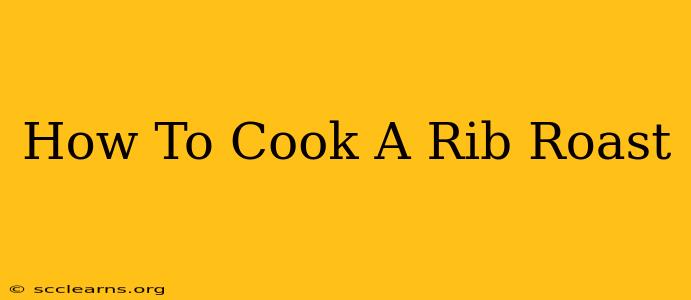A perfectly cooked rib roast is the centerpiece of any special occasion. Juicy, tender, and bursting with flavor, it's a dish that impresses even the most discerning palates. But achieving that perfect roast requires understanding a few key techniques. This guide will walk you through everything you need to know, from selecting the right cut to mastering the final resting period.
Choosing Your Rib Roast
The first step to a delicious rib roast is selecting the right cut. You'll typically find two main options:
- Standing Rib Roast: This cut includes the rib bones, resulting in a more dramatic presentation. It’s also known for excellent marbling and flavor.
- Boneless Rib Roast: This option is easier to carve and cooks more evenly, but it might lack some of the visual appeal of a standing rib roast.
Consider the size of your gathering when choosing your roast. A general rule of thumb is to allow about 1 pound of bone-in roast per person, or slightly less for boneless.
Preparing Your Rib Roast for Cooking
Before you even think about the oven, proper preparation is key. Here's what you should do:
- Bring it to Room Temperature: Take the roast out of the refrigerator at least 1-2 hours before cooking. This allows for more even cooking.
- Season Generously: Don't be shy with the seasoning! A simple blend of salt and pepper is excellent, but you can also experiment with garlic powder, onion powder, herbs like rosemary or thyme, or even a dry rub. Season all sides generously.
Cooking Methods: Oven Roasting and Reverse Searing
There are several ways to cook a rib roast, but two popular methods stand out:
Oven Roasting: The Classic Approach
This traditional method produces a beautifully browned and evenly cooked roast.
- Preheat your oven to the appropriate temperature. This will vary depending on the size of your roast and your desired level of doneness. A general guideline is 325°F (160°C) for a slower, more tender roast.
- Sear the roast (optional): For extra flavor and a beautiful crust, sear the roast in a hot skillet with a little oil before roasting.
- Roast until desired doneness is reached. Use a meat thermometer to ensure accuracy. Here's a temperature guide:
- Rare: 125°F (52°C)
- Medium-Rare: 130-135°F (54-57°C)
- Medium: 140-145°F (60-63°C)
- Medium-Well: 150-155°F (66-68°C)
- Well-Done: 160°F (71°C)
- Rest the roast: This crucial step allows the juices to redistribute, resulting in a more tender and flavorful roast. Let it rest for at least 20-30 minutes before carving.
Reverse Searing: For Maximum Tenderness
Reverse searing involves cooking the roast at a low temperature until almost fully cooked, then searing it at high heat to create a delicious crust. This method is great for achieving maximum tenderness.
- Cook low and slow: Cook the roast in a low oven (around 225°F/107°C) until it reaches a temperature about 20°F (11°C) below your desired final temperature.
- Sear: Once the roast is almost cooked, sear it in a very hot skillet or cast-iron pan to develop a beautiful crust.
- Rest: Let the roast rest as described above before carving.
Carving Your Rib Roast Like a Pro
Once the roast is rested, carving it properly is essential to reveal those beautiful slices. If it’s a bone-in roast, carefully remove the bone before slicing against the grain for maximum tenderness.
Serving Suggestions
A perfectly cooked rib roast pairs well with a variety of sides. Consider:
- Roasted vegetables: Potatoes, carrots, and asparagus are all excellent choices.
- Yorkshire pudding: A classic accompaniment to roast beef.
- Creamy horseradish sauce: A tangy counterpoint to the richness of the roast.
With a little practice and attention to detail, you can master the art of cooking a rib roast and create a truly memorable meal. Enjoy!

